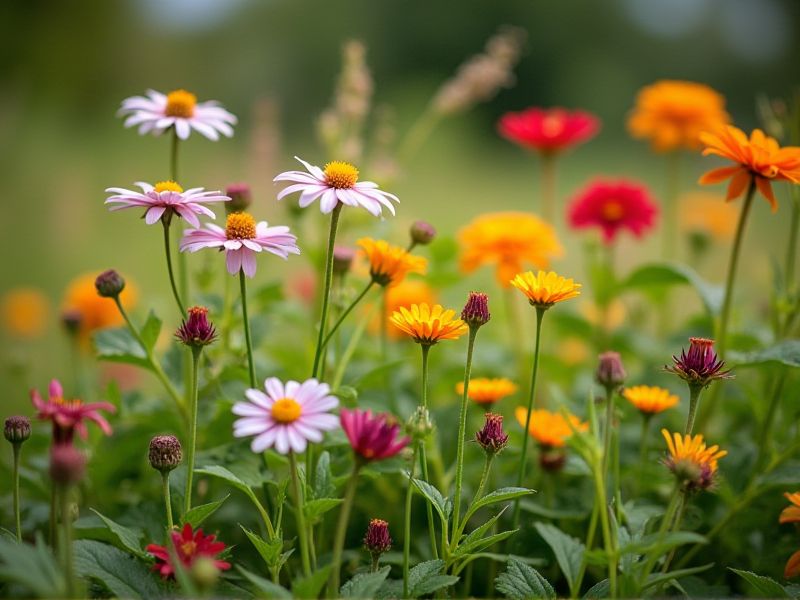
Wildflower plants such as clover, vetch, and bee balm are exceptional at enhancing soil health through nitrogen fixation and organic matter addition. These plants attract beneficial insects, promoting biodiversity and a balanced ecosystem in your garden. Deep-rooted wildflowers like coneflowers and black-eyed Susan help break compacted soil, improving aeration and water retention. Incorporating native wildflower species fosters resilience against pests and diseases while reducing the need for chemical fertilizers. Moreover, the vibrant blooms of these plants not only beautify your landscape but also support pollinators, creating a thriving environment for both flora and fauna.
List of some Wildflower plants that improve soil
- Red Clover (Trifolium pratense)
- Lupine (Lupinus spp.)
- Alfalfa (Medicago sativa)
- Sweet Clover (Melilotus spp.)
- Yarrow (Achillea millefolium)
- Chicory (Cichorium intybus)
- Birdsfoot Trefoil (Lotus corniculatus)
- Borage (Borago officinalis)
- Vetch (Vicia spp.)
- Comfrey (Symphytum officinale)
Important things about Wildflower plants that improve soil
Nitrogen Fixation Ability
Wildflower plants, such as clover and lupines, play a crucial role in nitrogen fixation, enhancing soil fertility. These plants harbor specialized bacteria in their root nodules, which convert atmospheric nitrogen into a form that is accessible for plant uptake. By incorporating wildflowers into your garden or agricultural practices, you not only improve soil quality but also promote biodiversity and attract beneficial pollinators. The presence of nitrogen-fixing wildflowers can lead to healthier ecosystems, supporting both native wildlife and crop production.
Deep Root Systems
Wildflower plants such as the purple coneflower and black-eyed Susan possess deep root systems that significantly enhance soil health. These extensive roots penetrate deeper layers of soil, improving aeration, water retention, and nutrient availability. As they grow, they create channels that facilitate the movement of air and water, promoting a thriving ecosystem for beneficial microbes. Incorporating these wildflowers into your garden not only beautifies the space but also leads to healthier, more fertile soil over time.
Erosion Control
Wildflower plants play a vital role in erosion control by enhancing soil stability and promoting biodiversity. Native species, such as Black-eyed Susan and Purple Coneflower, develop extensive root systems that anchor the soil, preventing it from washing away during heavy rains. The presence of wildflowers also improves soil quality by increasing organic matter and attracting beneficial insects, which support pollination. By incorporating wildflower meadows in your landscape, you can create a natural barrier against erosion while fostering a healthy ecosystem.
Biodiversity Support
Wildflower plants play a crucial role in enhancing soil health by promoting biodiversity and improving nutrient cycling. Species such as clover, sunflowers, and wild lupine contribute to nitrogen fixation, enriching the soil with essential nutrients that foster the growth of other plants. Their deep root systems help prevent soil erosion and increase water retention, creating a more stable environment for diverse organisms. By incorporating wildflower plants into your garden or landscape, you can support local ecosystems while benefiting your soil's overall vitality.
Pollinator Attraction
Wildflower plants, such as Black-eyed Susans and Bee Balm, not only attract essential pollinators like bees and butterflies but also significantly enhance soil health through nitrogen fixation and organic matter improvement. These vibrant blooms provide nectar and pollen, promoting biodiversity and supporting local ecosystems. When planted in your garden, these wildflowers can improve soil structure, reducing erosion while increasing water retention and fertility. Incorporating a diverse range of wildflower species in your landscape can create a sustainable environment that benefits both pollinators and soil quality.
Soil Structure Enhancement
Wildflower plants, such as purple coneflower and black-eyed Susan, play a crucial role in enhancing soil structure through their extensive root systems. These deep roots penetrate the soil, promoting aeration and increasing water infiltration, which reduces erosion and improves soil health. As wildflowers decompose, they contribute organic matter, enriching the soil with essential nutrients that support a thriving ecosystem. By incorporating wildflowers into your landscape, you can effectively enhance soil structure while promoting biodiversity and attracting beneficial pollinators.
Organic Matter Contribution
Wildflower plants play a significant role in enhancing soil quality through their organic matter contributions. As these plants grow and flourish, they produce biomass that, when decomposed, enriches the soil with essential nutrients, improving soil structure and fertility. The diverse root systems of wildflowers also enhance soil aeration and water retention, creating an optimal environment for beneficial microorganisms. By incorporating wildflowers into your landscape, you promote biodiversity and support sustainable land management practices that lead to healthier ecosystems.
Mycorrhizal Associations
Mycorrhizal associations play a crucial role in enhancing soil health for wildflower plants. These symbiotic relationships between fungi and plant roots facilitate nutrient absorption, particularly phosphorus, which is essential for plant growth. By improving soil structure and promoting microbial diversity, mycorrhizae also enhance soil moisture retention and resilience against erosion. Your wildflower garden can benefit from these associations, as they promote a thriving ecosystem while improving overall soil fertility.
Water Retention Improvement
Wildflower plants significantly enhance soil water retention, promoting healthier ecosystems. By planting native species such as bluebonnets or coneflowers, you create deep-root systems that improve soil structure and aeration. These rooting systems capture and retain moisture, reducing the need for frequent watering while supporting beneficial microorganisms. Embracing wildflowers in your landscape not only conserves water but also boosts biodiversity and attracts pollinators, making it a sustainable choice for gardening.
Pest And Disease Resistance
Wildflower plants, such as purple coneflower and black-eyed Susan, play a vital role in pest and disease resistance while enhancing soil health. These native species often attract beneficial insects, including pollinators like bees and natural predators of common garden pests, contributing to a balanced ecosystem. Their extensive root systems improve soil structure and fertility, promoting better water retention and nutrient availability. By incorporating wildflowers into your garden, you can not only enjoy their beauty but also create a more resilient landscape that supports biodiversity and soil vitality.
